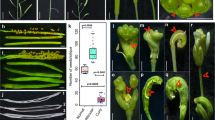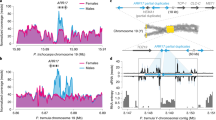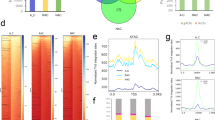Abstract
In diploid organisms, phenotypic traits are often biased by effects known as Mendelian dominant–recessive interactions between inherited alleles. Phenotypic expression of SP11 alleles, which encodes the male determinants of self-incompatibility in Brassica rapa, is governed by a complex dominance hierarchy1–3. Here, we show that a single polymorphic 24 nucleotide small RNA, named SP11 methylation inducer 2 (Smi2), controls the linear dominance hierarchy of the four SP11 alleles (S44 > S60 > S40 > S29). In all dominant–recessive interactions, small RNA variants derived from the linked region of dominant SP11 alleles exhibited high sequence similarity to the promoter regions of recessive SP11 alleles and acted in trans to epigenetically silence their expression. Together with our previous study4, we propose a new model: sequence similarity between polymorphic small RNAs and their target regulates mono-allelic gene expression, which explains the entire five-phased linear dominance hierarchy of the SP11 phenotypic expression in Brassica.
This is a preview of subscription content, access via your institution
Access options
Subscribe to this journal
Receive 12 digital issues and online access to articles
$119.00 per year
only $9.92 per issue
Buy this article
- Purchase on Springer Link
- Instant access to full article PDF
Prices may be subject to local taxes which are calculated during checkout




Similar content being viewed by others
References
Hatakeyama, K., Watanabe, M., Takasaki, T., Ojima, K. & Hinata, K. Dominance relationships between S-alleles in self-incompatible Brassica campestris L. Heredity 80, 241–247 (1998).
Shiba, H. et al. The dominance of alleles controlling self- incompatibility in Brassica pollen is regulated at the RNA level. Plant Cell 14, 491–504 (2002).
Kakizaki, T. et al. Linear dominance relationship among four class-II S haplotypes in pollen is determined by the expression of SP11 in Brassica self-incompatibility. Plant Cell Physiol. 44, 70–75 (2003).
Tarutani, Y. et al. Trans-acting small RNA determines dominance relationships in brassica self-incompatibility. Nature 466, 983–986 (2010).
Fisher, R. A. The possible modification of the response of the wild type to recurrent mutations. Am. Nat. 62, 115–126 (1928).
Billiard, S. & Castric, V. Evidence for Fisher's dominance theory: how many ‘special cases’? Trends Genet. 27, 441–445 (2011).
Takayama, S. & Isogai, A. Self-incompatibility in plants. Annu. Rev. Plant. Biol. 56, 467–489 (2005).
Suzuki, G. et al. Genomic organization of the S locus: identification and characterization of genes in SLG/SRK region of S(9) haplotype of Brassica campestris (syn. rapa). Genetics 153, 391–400 (1999).
Schopfer, C. R., Nasrallah, M. E. & Nasrallah, J. B. The male determinant of self-incompatibility in Brassica. Science 286, 1697–1700 (1999).
Takayama, S. et al. The pollen determinant of self-incompatibility in Brassica campestris. Proc. Natl Acad. Sci. USA 97, 1920–1925 (2000).
Stein, J. C., Howlett, B., Boyes, D. C., Nasrallah, M. E. & Nasrallah, J. B. Molecular cloning of a putative receptor protein kinase gene encoded at the self-incompatibility locus of Brassica oleracea. Proc. Natl Acad. Sci. USA 88, 8816–8820 (1991).
Takasaki, T. et al. The S receptor kinase determines self-incompatibility in Brassica stigma. Nature 403, 913–916 (2000).
Kachroo, A., Schopfer, C. R., Nasrallah, M. E. & Nasrallah, J. B. Allele-specific receptor-ligand interactions in Brassica self-incompatibility. Science 293, 1824–1826 (2001).
Takayama, S. et al. Direct ligand-receptor complex interaction controls Brassica self-incompatibility. Nature 413, 534–538 (2001).
Shiba, H. et al. Dominance relationships between self-incompatibility alleles controlled by DNA methylation. Nat. Genet. 38, 297–299 (2006).
Fukai, E., Fujimoto, R. & Nishio, T. Genomic organization of the S core region and the S flanking regions of a class-II S haplotype in Brassica rapa. Mol. Genet. Genomics 269, 361–369 (2003).
Kakizaki, T. et al. Comparative analysis of the S-intergenic region in class-II S haplotypes of self-incompatible Brassica rapa (syn. campestris). Genes Genet. Syst. 81, 63–67 (2006).
Shiba, H. et al. Genomic organization of the S-locus region of Brassica. Biosci. Biotechnol. Biochem. 67, 622–626 (2003).
Kimura, R., Sato, K., Fujimoto, R. & Nishio, T. Recognition specificity of self-incompatibility maintained after the divergence of Brassica oleracea and Brassica rapa. Plant J. 29, 215–223 (2002).
Chen, C. et al. Real-time quantification of microRNAs by stem-loop RT–PCR. Nucleic Acids Res. 33, e179 (2005).
Bologna, N. G., Mateos, J. L., Bresso, E. G. & Palatnik, J. F. A loop-to-base processing mechanism underlies the biogenesis of plant microRNAs miR319 and miR159. EMBO J. 28, 3646–3656 (2009).
Mateos, J. L., Bologna, N. G., Chorostecki, U. & Palatnik, J. F. Identification of microRNA processing determinants by random mutagenesis of Arabidopsis MIR172a precursor. Curr. Biol. 20, 49–54 (2010).
Zhu, H. et al. Bidirectional processing of pri-miRNAs with branched terminal loops by Arabidopsis Dicer-like1. Nat. Struct. Mol. Biol. 20, 1106–1115 (2013).
Fahlgren, N. & Carrington, J. C. miRNA target prediction in plants. Methods Mol. Biol. 592, 51–57 (2010).
Durand, E. et al. Dominance hierarchy arising from the evolution of a complex small RNA regulatory network. Science 346, 1200–1205 (2014).
Kowyama, Y. et al. Number, frequency and dominance relationships of S-alleles in diploid Ipomoea trifida. Heredity 73, 275–283 (1994).
Brennan, A. C., Tabah, D. A., Harris, S. A. & Hiscock, S. J. Sporophytic self-incompatibility in Senecio squalidus (Asteraceae): S allele dominance interactions and modifiers of cross-compatibility and selfing rates. Heredity 106, 113–123 (2011).
Casci, T. Gene expression: small but dominant RNA. Nat. Rev. Genet. 11, 670–671 (2010).
Langmead, B., Trapnell, C., Pop, M. & Salzberg, S. L. Ultrafast and memory-efficient alignment of short DNA sequences to the human genome. Genome Biol. 10, R25 (2009).
Acknowledgements
We thank K. Kubo for helpful comments and E. Mori, Y. Yamamoto, Y. Yoshimura, F. Kodama, H. Ichikawa, M. Okamura and M. Nara for technical assistance. This work was supported in part by Grants-in-Aid for Scientific Research on Innovative Areas (23113002 and 16H06467 to S.T.; 23113001 to G.S., M.W. and S.T.; 16K21727 and 16H06470 to M.W.; and 16H06464 to M.W. and S.T.) and Grants-in-Aid for Scientific Research (25252021 and 16H06380 to S.T. and 16H04854 to M.W.) from the Ministry of Education, Culture, Sports, Science and Technology of Japan (MEXT); the Program for Promotion of Basic Research Activities for Innovative Biosciences (to S.T.) from the Bio-oriented Technology Research Advancement Institution (BRAIN); and Grants in Aid for JSPS Research Fellow (14J10324 to S.Y.) from the Japan Society for the Promotion of Science (JSPS).
Author information
Authors and Affiliations
Contributions
S.T. and M.W. designed this project. T.K., G.S. and M.W. identified SMI2. S.Y., T.K., G.S., Y. Takada, Y. Tarutani, E.M.-U. and H.S. performed the sequence analyses of the S-locus. S.Y., Y. Tarutani, E.M.-U. and K.M. performed the expression analysis of Smi2. Y.W., E.M.-U., T.H., T.S., Y. Takada, H.S. and T.T.-Y. performed transformation and analysis of transformants. S.F. performed the phylogenetic analysis. S.Y., Y.W. and S.T. wrote the manuscript, which was edited by all of the authors.
Corresponding authors
Ethics declarations
Competing interests
The authors declare no competing financial interests.
Supplementary information
Supplementary Information
Supplementary Methods, Supplementary Figures 1–5, Supplementary Tables 1–5, Supplementary References. (PDF 1008 kb)
Rights and permissions
About this article
Cite this article
Yasuda, S., Wada, Y., Kakizaki, T. et al. A complex dominance hierarchy is controlled by polymorphism of small RNAs and their targets. Nature Plants 3, 16206 (2017). https://doi.org/10.1038/nplants.2016.206
Received:
Accepted:
Published:
DOI: https://doi.org/10.1038/nplants.2016.206
This article is cited by
-
Dominance in self-compatibility between subgenomes of allopolyploid Arabidopsis kamchatica shown by transgenic restoration of self-incompatibility
Nature Communications (2023)
-
Applications and challenges of harnessing genome editing in oilseed crops
Journal of Plant Biochemistry and Biotechnology (2023)
-
MLPK function is not required for self-incompatibility in the S29 haplotype of Brassica rapa L.
Plant Reproduction (2023)
-
Parallel evolution of dominant pistil-side self-incompatibility suppressors in Arabidopsis
Nature Communications (2020)
-
Mechanism of self/nonself-discrimination in Brassica self-incompatibility
Nature Communications (2020)



